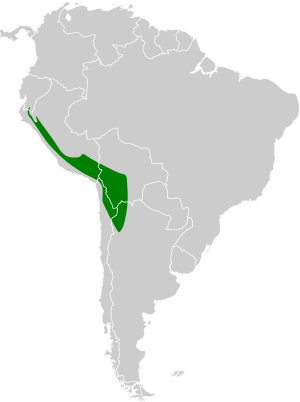Puna snipe facts for kids
Quick facts for kids Puna snipe |
|
|---|---|
| Conservation status | |
| Scientific classification | |
 |
The puna snipe (Gallinago andina) is a special type of bird. It belongs to the sandpiper family. These birds live in parts of South America, including Argentina, Bolivia, Chile, and Peru.
Contents
About the Puna Snipe
How Scientists Classify This Bird
For a long time, scientists found it tricky to classify snipes from the New World (North and South America). The puna snipe was once thought to be a subspecies of the common snipe. This means it was seen as a different type of the same bird.
Later, two other snipes, the Pantanal snipe and the Magellanic snipe, were sometimes thought to be subspecies of the puna snipe. But around the year 2000, most scientists agreed. They decided that the puna snipe, Pantanal snipe, and Magellanic snipe are all separate species.
Today, the puna snipe has two recognized subspecies. These are G. a. andina and G. a. innotata.
What Does the Puna Snipe Look Like?
The puna snipe is a medium-sized bird. It is about 22.5 to 25 centimeters (9 to 10 inches) long. It usually weighs between 65 and 105 grams (2.3 to 3.7 ounces). Male and female puna snipes look very similar.
Their upper body has a mix of colors. These include muted white, light brown, reddish-brown, black, and dark brown. When they fly, you can see white edges on their wings. Their chest and sides are light brown with black marks. The rest of their underside is white. They have a white face with a clear brown stripe going through their eye.
Where the Puna Snipe Lives
Distribution and Habitat
The main subspecies, G. a. andina, lives in the Andes mountains. You can find it in Peru, northern Chile, Bolivia, and northwestern Argentina. Some people have reported seeing it in Ecuador, but this is not fully confirmed.
The other subspecies, G. a. innotata, is only found in the Antofagasta Region of northern Chile.
Puna snipes live in the puna grassland areas of the Andes. They prefer wet places. This includes marshy rivers, bogs with cushion plants, and the reedy edges of ponds, lakes, and rivers. Sometimes, they also live in open reed marshes. They live at high elevations. In Peru, they are found between 3,000 and 4,600 meters (9,800 and 15,100 feet) high. In Chile, they live between 2,000 and 5,000 meters (6,600 and 16,400 feet). In Argentina, they are found between 2,000 and 4,000 meters (6,600 and 13,100 feet).
Puna Snipe Behavior
Movement
Some puna snipes from Argentina move east during the southern winter. They travel to the flat grasslands called the pampas. Birds in Chile and Peru also move to lower areas, but not as far. Scientists do not know much about the movements of the G. a. innotata subspecies.
Feeding Habits
Scientists have not studied the puna snipe's feeding habits much. However, they believe it eats and finds food like other South American snipes. These birds usually look for insect larvae and earthworms. They do this by probing their long beaks into mud and wet soil.
Reproduction and Life Cycle
The puna snipe's breeding season changes depending on where they live. In Peru, they mostly breed between October and December. In northern Chile, their breeding season starts at least in September.
During courtship, the male puna snipe performs a special "winnowing" display. He flies high in circles. Then, he makes shallow dives. As he dives, air flows over his outer tail feathers. This creates a unique drumming sound. Not much else is known about how these birds reproduce.
Sounds and Calls
The puna snipe makes different sounds. When it sings from the ground, it makes a fast, soft sound. It sounds like "tip-tip-tip-tip...", "cut-cut-cut-cut...", or "dyak dyak dyak .... dyuc dyuc dyuc...".
When it takes flight, it makes a sharp, dry sound. This sounds like "chep chep chep!", "che’che’che", or "dzeetch". The special "winnowing" sound it makes while flying is not a call. It is made by air moving over its tail feathers. This sound is described as a long, stuttering whoosh, like "tch’ch’ch’ch’".
Conservation Status
The IUCN (International Union for Conservation of Nature) has evaluated the puna snipe. They have listed it as a species of "Least Concern." This means that the bird is not currently in danger of extinction. It lives across a fairly large area. Even though its exact population size is unknown, scientists believe it is stable. No immediate threats to the puna snipe have been found. It is considered quite common in Peru and less common in Chile.
See also
 In Spanish: Agachadiza de la puna para niños
In Spanish: Agachadiza de la puna para niños


